n2doc
n2doc's JournalBlack hole’s annual feast begins
by Nadia Drake

HLX-1, the only known intermediate-mass black hole (circled), hovers above the plane of a nearby galaxy, as seen in this Hubble Space Telescope image. Astronomers are debating the source of the light coming from the area around the black hole.NASA, ESA, S. Farrell/Sydney Institute for Astronomy
BEIJING — A black hole about 290 million light-years away has just begun slurping material from its surroundings, an annual ritual revealed by a periodic brightening in X-ray wavelengths.
“It is picking up again, just today — or last night — which is good,” astronomer Roberto Soria of the International Center for Radio Astronomy Research in Perth, Australia, said August 22 at the 28th General Assembly of the International Astronomical Union. “I was starting to get a bit worried because this cycle was three or four days late.”
The black hole, known as HLX-1, is 10,000 times as massive as the sun and the only known specimen in its weight class. Middleweights like HLX-1, which should be numerous, are intermediate between the supermassive black holes at galactic cores — as massive as billions of suns — and the featherweights with just a few solar masses.
First detected by X-ray telescopes in 2009, HLX-1 has since been spied upon in visible wavelengths by the Hubble Space Telescope and other instruments. Those observations revealed a mysterious, bluish glow surrounding the object, which hovers above the plane of a distant galaxy. Now, scientists are trying to determine where the glow is coming from, how HLX-1 formed, and where the rest of the intermediate-mass black holes are hiding.
more
http://www.sciencenews.org/view/generic/id/343249/description/Black_hole’s_annual_feast_begins
Curiosity - sols 3 & 13 - Bradbury Landing Panorama
On sol 13 Curiosity took a few more images to add the peak of Mt Sharp/ Aeolis Mons into the initial panorama from Bradbury Landing. Here is my attempt to add these images and to extend the sky to make the composition a bi better.

And here is a crop with slight enhancement of just the mountain (Mt Sharp or Aeolis Mons). A sight to behold!

Truly impressive full size versions at link
http://www.nivnac.co.uk/mer/index.php/msl3v3
Red-Giant Star Eating it's own Planet discovered
By Thomas H. Maugh II
August 21, 2012, 10:29 a.m.
For the first time, astronomers have seen evidence of an aging star consuming its own planet. Such events are not uncommon as aging stars expand in size, engulfing nearby planets. But the events happen relatively quickly on a cosmological time scale and it is considered unlikely for one to be observed directly.
The star in question is known as a red giant. Such stars begin with a mass about the same as that of the Earth's sun. As they age, the hydrogen fusion reactions in their core become less efficient and most of the fusion is transferred to the outer shell of gases. The increased fusion makes the shell hotter and as much as 1,000 times brighter than normal, causing the diameter of the star to expand continually until its radius reaches a size equivalent to the Earth's distance from the sun.
A team headed by astronomer Alexander Wolszczan of Penn State University used the 9.2-meter (362-inch) Hobby-Eberly Telescope at the McDonald Observatory in the Davis Mountains of Texas to study a red giant star named BD+48 740. They reported in Astrophysical Journal Letters that the star has a diameter about 11 times that of our sun. Spectroscopy showed that the star contains an abnormally high amount of lithium, a rare element created primarily during the Big Bang.
Lithium is normally consumed in the fusion reactions of stars, so its presence in such high concentrations is unusual. One alternative method by which lithium can be formed is when a star consumes a planet, and the researchers believe that is what happened in this case.
more
http://www.latimes.com/news/science/sciencenow/la-sci-sn-star-eats-planet-20120821,0,1056613.story?track=rss
Let’s Void the Tour de France from 1999 to 2005
By Jeremy Stahl
“Seven-time Tour de France winner Lance Armstrong” will soon just be Lance Armstrong. The most celebrated cyclist on the planet has decided to end his fight against doping charges, claiming that the U.S. Anti-Doping Agency’s legal process was an “unconstitutional witch hunt” after losing his most recent legal challenge.
The agency has banned Armstrong from all competition for life and is now recommending that the International Cycling Union strip the Texan of his record number of maillots jaunes, an outcome that now seems more likely than not.
One of the biggest questions for cycling fans now becomes what happens to Lance’s titles? Having covered professional cycling for the three years after Armstrong’s retirement, I can tell you that the sport was at the time marred more by major doping scandals involving Lance’s successors then it was by the shadows hanging over Armstrong’s own career.
Every single rider that finished second to Lance has since been connected to doping, and the majority of them have either been directly convicted in ways comparable to Armstrong or confessed to their own crimes.
more
http://www.slate.com/blogs/browbeat/2012/08/24/lance_armstrong_doping_scandal_everyone_was_chating_from_1999_to_2005_.html
Most Mutations Come from Dad
ScienceDaily (Aug. 23, 2012) — Humans inherit more than three times as many mutations from their fathers as from their mothers, and mutation rates increase with the father's age but not the mother's, researchers have found in the largest study of human genetic mutations to date.
The study, based on the DNA of around 85,000 Icelanders, also calculates the rate of human mutation at high resolution, providing estimates of when human ancestors diverged from nonhuman primates. It is one of two papers published this week by the journal Nature Genetics as well as one published at Nature that shed dramatic new light on human evolution.
"Most mutations come from dad," said David Reich, professor of genetics at Harvard Medical School and a co-leader of the study. In addition to finding 3.3 paternal germline mutations for each maternal mutation, the study also found that the mutation rate in fathers doubles from age 20 to 58 but that there is no association with age in mothers -- a finding that may shed light on conditions, such as autism, that correlate with the father's age.
The study's first author is James Sun, a graduate student in Reich's lab who worked with researchers from deCODE Genetics, a biopharma company based in Reykjavik, Iceland, to analyze about 2,500 short sequences of DNA taken from 85,289 Icelanders in 24,832 father-mother-child trios. The sequences, called microsatellites, vary in the number of times that they repeat, and are known to mutate at a higher rate than average places in the genome.
more
http://www.sciencedaily.com/releases/2012/08/120824103020.htm
Hubble’s Hidden Treasures Revealed (big space pics!)


Hubble has made over a million observations since launch, but only a small proportion are attractive images — and an even smaller number are ever actually seen by anyone outside the small groups of scientists that publish them. But the vast amount of data in the archive means that there are still many hundreds of beautiful images scattered among the valuable, but visually unattractive, scientific data that have never been enjoyed by the public.
We call these pictures Hubble’s hidden treasures, and a few months ago, we invited the public to look through Hubble’s science archive to help us find them.
The response was impressive, with almost 3000 submissions. More than a thousand of these images were fully processed: a difficult and time-consuming task. We’ve already started featuring the best of these in our Hubble Picture of the Week series.
And to say thanks, we’re awarding prizes for the best images you found.


more!
http://www.spacetelescope.org/announcements/ann1211/
Friday TOON Roundup 6- Harry's Jewels and the rest
Media

Food


Lance

Harry



Bad Reporter

Friday TOON Roundup 5- Mitt and politics
[h2]Mitt


Politics

History

Economy

Property


Profile Information
Gender: Do not displayMember since: Tue Feb 10, 2004, 01:08 PM
Number of posts: 47,953





